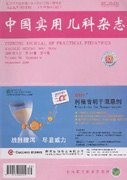|
Clinical characteristics of E. coli meningitis in fifty-seven cases
MI Yu-mei,YUAN Tian-ming,CHEN Li-hua,et al
2020, 35(7):
562-566.
DOI: 10.19538/j.ek2020070616
Objective To retrospectively study the clinical characteristics of bacterial meningitis in children caused by E.coli,and to provide evidence for clinical treatment and prediction of prognosis. Methods Totally 57 children with bacterial meningitis admitted to Children’s Hospital affiliated to Zhejiang University from January 2013 to December 2017 were collected. E.coli was isolated in cerebrospinal fluid(CSF) or(and) blood culture. Summarize the disease progression,clinical manifestations and features of CSF and imaging,and analyze the difference between without-complicat and with-complication E.coli meningitis in children. Results Among 57 children,at the onset,28 children had diarrhea(49.1%),7 children had urinary tract infection(12.3%),1 child had perianal abscess(1.7%) and 1 child had intestinal perforation(1.7%);25 children were cured without complications(43.9%),21 children(36.8%) survived with complications. Complications included subdural effusion/pus,hydrocephalus,ventriculitis,encephalomalacia and hearing impairment. All the dead children had severe intracranial lesions,including hydrocephalus,ventriculitis and massive encephalomalacia. Meanwhile,one dead child also had hearing impairment. Among the surviving children,comparison was made between with-complications group and without-complications group,and there were statistical differences between the two groups in these aspects,such as the rate of seizure(χ2=4.436,P<0.05),the rate of using effective antibiotics in 48 hours after onset(χ2=3.946,P<0.05),total periods of fever(Z=-2.941,P<0.05)and the levels of micro total protein(MTP)(Z=-2.026,P<0.05),glucose concentration(t=2.124,P<0.05)and lactate dehydrogenase(LDH)(Z=-2.263,P<0.05)in the CSF in the initial course of disease. Comparison between relapse group and group without complications and relapse,there were statistical differences between the two groups in these aspects such as the rate of premature[P<0.05(Fisher test)],the rate of ESBL positive(χ2=4.142,P<0.05),and the levels of glucose concentration(t=2.801,P<0.05)、LDH(Z=-2.227,P<0.05). Comparison the death and survival group,there were statistical differences between the two groups in these aspects such as the rate of premature(χ2=6.468,P<0.05),the rate of seizure(χ2=4.998,P<0.05)and the levels of white blood cell(Z=-2.201, P<0.05)、 MTP(Z=-2.664,P<0.05)、glucose concentration(t=9.812,P<0.05)、LDH(Z=-3.830,P<0.05). Conclusion E.coli meningitis mostly occurs in children younger than 3 months. Premature delivery,seizure,when to start effective antibiotics treatment,duration of fever,ESBLs and the levels of MTP,glucose and LDH in CSF can be used as important prognostic indicators of E.coli meningitis.
|

